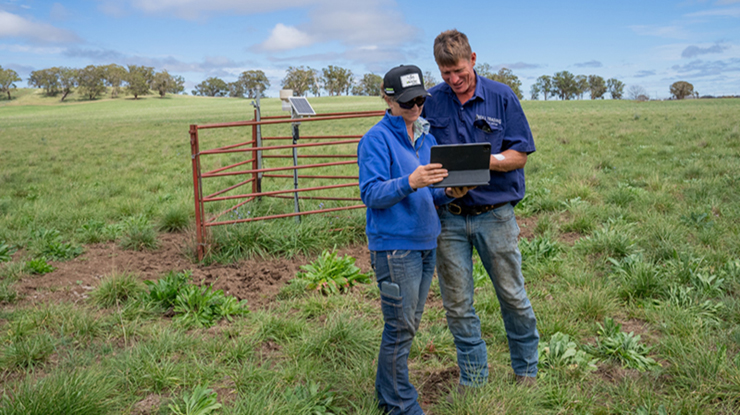 Jane Mactier and Rodney Neill (pictured) look at data collected from moisture probes and rain gauges, as part of the MDC project. Image: Agrishots
Jane Mactier and Rodney Neill (pictured) look at data collected from moisture probes and rain gauges, as part of the MDC project. Image: Agrishots
The commonly held perception that increasing soil organic carbon can only be achieved with reliable and consistent soil moisture has been called into question by early findings in an MLA led grazing trial across NSW's New England region.
The MLA Donor Company (MDC) project, 'Grazing system impact on livestock productivity, soil moisture and soil organic carbon', raised interesting questions about the relationship between soil organic carbon, soil moisture and rotational grazing.
The project, which is coordinated by soil and pasture agronomy company Precision Pastures, monitors 10 farms from Walcha to Bingara. Data is being collected from soil moisture probes, soil sampling, rain gauges and pasture cuts.
One of the host sites is at 'Tenterden Station', near Guyra – home to Jane Mactier and Rodney Neill.
They produce pasture-fed Angus-cross cattle, superfine Merinos and Australian White sheep, and finish stock which are sold direct to processors and supermarkets.
Digging deeper
Jane and Rodney joined the MDC project to obtain deeper knowledge of their soil moisture and carbon levels, to assist with decision making around pasture management.
They purchased Tenterden Station in 2018 and saw an opportunity to further develop and improve the land through various activities – a major focus being intensive grazing.
"We converted the grazing system to rotational grazing according to feed availability instead of set-time rotations," Rodney said.
They also installed additional dams and troughs to ensure there was enough quality water.
Dry challenges
It hasn't always been smooth sailing, as the purchase of Tenterden coincided with the 2019 drought. Rodney and Jane said this reinforced the importance of rotational grazing to rest paddocks and maintain ground cover.
During the drought years, they managed to maintain 22,500 dry sheep equivalent (DSE). They currently run approximately 45,000 DSE.
After the drought, they were unsure which pasture species had survived, so they took the opportunity to replant improved pasture in most of their paddocks, using a combination of disc seeding and broadcasting seeds using vehicles, drones and aeroplanes.
They also trialled different products including microbial stimulants to promote root growth and stimulate the soil biology.
Results
Rodney and Jane said the results speak for themselves, as careful management of pastures has increased soil organic carbon.
On the project paddocks, soil organic carbon levels have, on average, increased by 1.46% in the topsoil (0–15cm depth) and 0.17% at a depth of 15–30cm, between October 2022 and October 2023, despite lengthy dry spells during 2023.
Baseline carbon levels in October 2022 were 2.60% and 1.75%, at depths of 0–10cm and 10–30cm respectively.
"We believe the kick-up in carbon levels is partly attributed to our high intensity rotational grazing program," Rodney said.
"It's very important we do not over or under-graze these pastures. Perhaps at times, we must have a compromise between the 'ideal' grazing management, animal health and overall farm management.
"Even though Tenterden received some big rainfall events at the end of 2023, we haven't seen any runoff, so though rotational grazing, we are ensuring constant ground cover which is keeping roots in the ground and helping water infiltration."
Future focus
Jane and Rodney would consider registering a soil carbon project if they were to buy an undeveloped property, where they could implement significant changes, such as cell grazing and improved pasture.
Due to the improved grazing management adopted at Tenterden, Jane and Rodney are not sure how close to saturation in carbon levels the soils are. This means they do not know what the potential grains in soil carbon levels over time might still be.
For them the primary importance of increasing soil carbon is to increase production – if they maintain increased carbon levels, they will maintain a higher production level.






